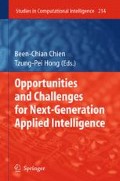Abstract
The purpose of this study is to implement an Internet assessment on probability reasoning which provides graphs of rule usage and similarity coefficient in comparison with expert. Ordering theory (OT) combined with interpretive structural modeling (ISM) is the method to construct structural graphs of rule usage on probability reasoning. Set operation is adopted to calculate the similarity coefficient for graphs of rule usage. An empirical study for pupils shows that rule usage varies with the total score and there is significant difference on similarity coefficient based on age, gender and interaction. Finally, some recommendations and suggestions for future research are discussed.
Access this chapter
Tax calculation will be finalised at checkout
Purchases are for personal use only
Preview
Unable to display preview. Download preview PDF.
References
Piaget, J., Inhelder, B.: The Origin of the Idea of Chance in Children. Routledge and Kegan Paul (1975)
Konold, C.: Informal concepts of probability. Cognition and Instruction 6, 59–98 (1989)
Siegler, R.S.: Developmental of sequences within and between concepts. Society for Research in Child Development Monographs 46, Whole No. 189 (1981)
Siegler, R.S.: The rule-assessment approach and education. Contemporary Educational Psychology 7, 272–288 (1982)
Warfield, J.N.: Interpretive structural modeling (ISM). In: Olsen, S.A.W.E., Walter, W.V., Lehner, W. (eds.) Group Planning & Problem Solving Methods in Engineering, pp. 115–201. Wiley, New York (1982)
Bart, W.M., Krus, D.J.: An ordering-theoretic method to determine hierarchies among items. Educational and Psychological Measurement 33, 291–300 (1973)
Bart, W.M., Williams-Morris, R.: A refined item diagraph analysis of proportional reasoning test. Applied Measurement in Education 3, 143–165 (1990)
Bart, W.M., Post, T., Behr, M., Lesh, R.: A diagnostic analysis of a proportional reasoning test item: An introduction to the properties of a semi-dense item. Focus on Learning Problems in Mathematics 16, 1–11 (1994)
Jansen, B.R.J., Han van der Maas, M.L.J.: Statistical test of the rule assessment methodology. Developmental Review 17, 321–357 (1997)
Lin, Y.H., Hung, W.L.: Robust clustering on rule usage of probability reasoning with raw rule score. In: The 4th International Conference on Fuzzy Systems and Knowledge Discovery, Haikou, China, pp. 251–255 (2007)
Cosmides, L., Tooby, J.: Are humans good intuitive statisticians after all? Rethinking some conclusions from the literature on judgment under uncertainty. Cognition 58, 1–73 (1996)
Fischbein, E., Gazit, A.: Does the teaching of probability improve probabilistic intuitions? Educational Studies in Mathematics 15, 1–24 (1984)
Tarr, J.E., Jones, G.A.: A framework for assessing middle school students’ thinking in conditional probability and independence. Mathematics Education Research Journal 9, 39–59 (1997)
Bart, W.M., Rothen, W., Read, S.: An ordering-analytic approach to the study of group differences in intelligence. Educational and Psychological Measurement 46, 799–812 (1986)
Goldsmith, T.E., Johnson, P.J., Acton, W.H.: Assessing structural knowledge. Journal of Educational Psychology 83, 88–96 (1991)
Warfield, J.N.: Crossing theory and hierarchy mapping. IEEE Transactions on System, Man, and Cybernetics 7, 505–523 (1977)
Author information
Authors and Affiliations
Editor information
Editors and Affiliations
Rights and permissions
Copyright information
© 2009 Springer-Verlag Berlin Heidelberg
About this chapter
Cite this chapter
Lin, YH. (2009). Probability Reasoning Internet Assessment System with Rule Usage Structures and Similarity Comparisons. In: Chien, BC., Hong, TP. (eds) Opportunities and Challenges for Next-Generation Applied Intelligence. Studies in Computational Intelligence, vol 214. Springer, Berlin, Heidelberg. https://doi.org/10.1007/978-3-540-92814-0_31
Download citation
DOI: https://doi.org/10.1007/978-3-540-92814-0_31
Publisher Name: Springer, Berlin, Heidelberg
Print ISBN: 978-3-540-92813-3
Online ISBN: 978-3-540-92814-0
eBook Packages: EngineeringEngineering (R0)

